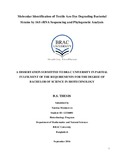| dc.contributor.advisor | Siddique, Romana | |
| dc.contributor.author | Momtareen, Taizina | |
| dc.date.accessioned | 2017-03-12T05:22:54Z | |
| dc.date.available | 2017-03-12T05:22:54Z | |
| dc.date.copyright | 2016 | |
| dc.date.issued | 2016 | |
| dc.identifier.other | ID 12336001 | |
| dc.identifier.uri | http://hdl.handle.net/10361/7879 | |
| dc.description | This Thesis is submitted in partial fulfillment of the requirements for the degree of Bachelor of Science in Biotechnology, 2016. | en_US |
| dc.description | Cataloged from PDF version of thesis report. | |
| dc.description | Includes bibliographical references (page 63-65). | |
| dc.description.abstract | Colours in the form of dyes are an absolute necessity in the manufacturing of commodities. Synthetic dyes and mordants are used by the food, textiles, tanning, and paper industries to name a few. Used to enhance the aesthetic appeal of products, these dyes cause severe damage to the environment. The discharge of synthetic dyes into the environment without proper effluent treatment results in inevitable harm to all the components of the ecosystem. Moreover, the high expense of actively maintaining an Effluent Treatment Plant (ETP) by industries is considered a huge factor in heavily reducing profits, especially in third world countries like Bangladesh. Due to this, factories often evade the necessary effluent treatment and thereby cause high degrees of environmental pollution. Bioremediation offers a great and affordable solution to this seemingly unavoidable dilemma. When a microorganism is found in a particular environment, it indicates that that microorganism is able to feed on and metabolize the ingredients constituting the environment. Similarly, microorganisms present in industrial effluents containing high quantities of synthetic dyes should be able to breakdown and metabolize those dyes. Keeping this in mind, two bacterial strains have been isolated from the effluent of a textile industry near Dhaka. Molecular tests such as PCR, agarose gel electrophoresis, 16S rRNA sequencing, and phylogenetic tree construction and analysis were performed to identify one of the strains as a species under the genus Providencia. This bacterium has performed well in degrading the azo dye „Reactive Red 3BX‟. If used in combination with other dye degrading bacteria, this bacterium is expected to provide success in the biodegradation of harmful azo dyes. Thus it is a prime candidate to contribute to the cleaning of environmental pollution caused by azo dyes. | en_US |
| dc.description.statementofresponsibility | Taizina Momtareen | |
| dc.format.extent | 68 pages | |
| dc.language.iso | en | en_US |
| dc.publisher | BRAC University | en_US |
| dc.rights | BRAC University thesis are protected by copyright. They may be viewed from this source for any purpose, but reproduction or distribution in any format is prohibited without written permission. | |
| dc.subject | Azo Dye degrading | en_US |
| dc.title | Molecular identification of Textile Azo Dye degrading bacterial strains by 16S rRNA sequencing and phylogenetic analysis | en_US |
| dc.type | Thesis | en_US |
| dc.contributor.department | Department of Mathematics and Natural Sciences, BRAC University | |
| dc.description.degree | B. Biotechnology | |

